The CTA is getting ready for RPM, the mother of all Chicago transit projects
6:25 PM CDT on September 10, 2019
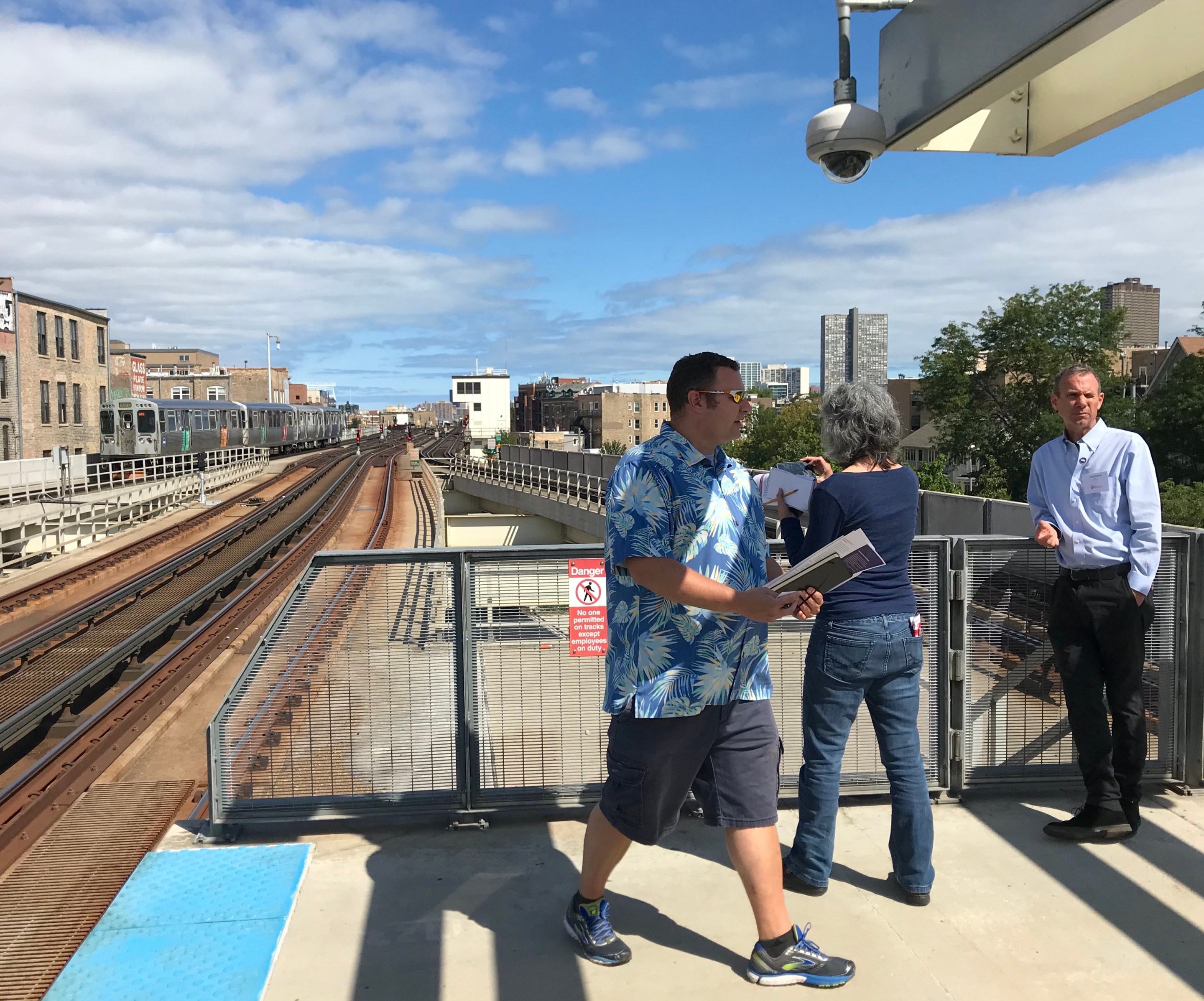
Journalists check out the future site of the Belmont Flyover with CTA staffer Chris Bushell, right. The flyover will pass by the white control tower, with the tops of northbound Brown Line trains a bit higher than the top of the tower. Photo: John Greenfield
Last week I, along with a few other Rita Skeeter types, was invited to a press event in the CTA's top-secret briefing room, aka the former basement-level sneaker and skateboard department of Lakeview's shuttered Belmont Army store. We were there to discuss the $2.1 billion first phase of the Red and Purple Modernization project (RPM), the biggest single initiative in the history of the transit agency. Phase I involves rehabbing four stations in Uptown and Edgewater; track and signal improvements; and the controversial Belmont Flyover, which will address a conflict area just north of the Belmont Red, Purple, and Brown stop by routing northbound Brown trains over the other tracks.
CTA president Dorval Carter Jr. kicked off the roundtable by discussing the origins of the massive project back in 2007, when staffers argued that "if we don't rebuild RPM, it's going to fall apart. In January 2017, just before the transit-hostile Trump administration took over Washington D.C., Barack Obama essential put out a lifeboat for RPM, in the form of $1.1 billion in funding. Much of the remainder of the cost will be covered by revenue generated by a tax-increment financing district that was designated around the project area. "There's no project in my career that I've felt more connected to than the RPM project," Carter said.
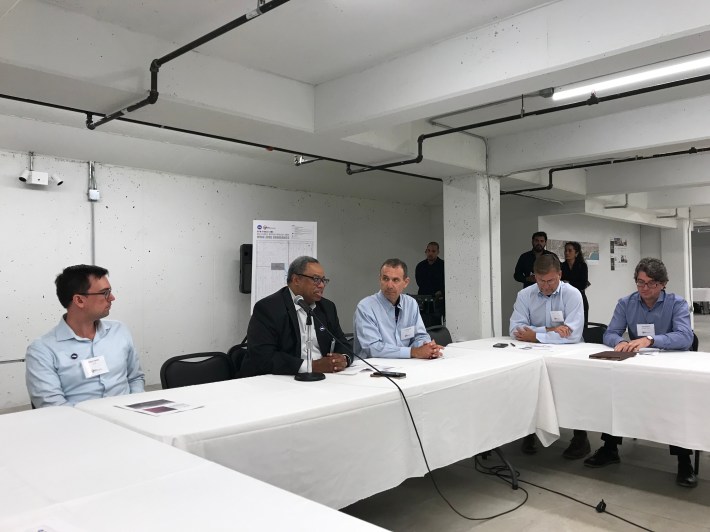
Carter cited the Wilson station rehab and the 95th Street Reed Line terminal reconstruction as other ambitious CTA projects that were arguably carried out successfully. He asserted that, like those initiatives, RPM will have positive impacts for people across Chicago. "Even though this project is being built on the North Side of the city, it's going to benefit the entire city."
Carter said that in planning the project, the CTA has focused on job creation, workforce development, and POC- and woman-owned business participation. 20 percent of the design work and 20 percent of the construction work will go to such firms, called Disadvantage Business Enterprises, which he said is among the highest DBE participation in any major U.S. project.
Next RPM project executive Chris Bushell provided an overview of the nuts and bolts of RPM. He noted that the 24/7 service on the Red Line provides roughly 75 million rides per year on a century-old structure. The entire RPM project covers 9.6 miles of track, from Belmont Avenue to Howard Street.
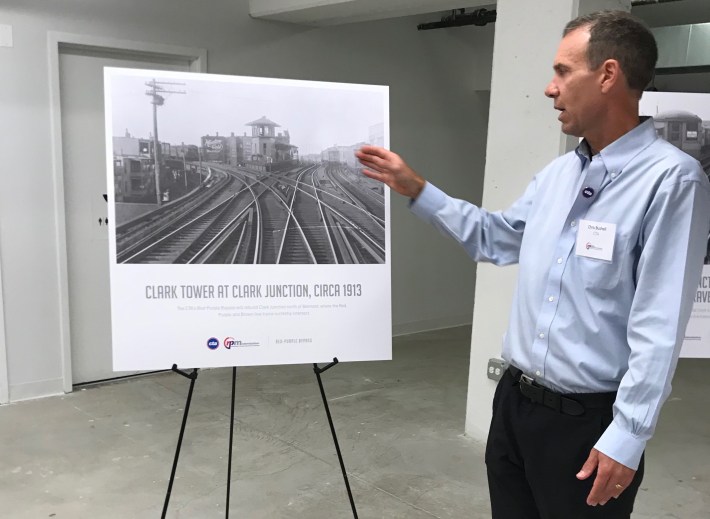
Bushell discussed the Belmont Flyover, officially called the Red-Purple Bypass, which was contentious because it required the demolition of about 16 local buildings. It will be constructed between this fall and winter 2024. Currently Red and Purple line trains must wait for northbound Brown trains to pass them at the same grade. The CTA says separating the grades with the flyover will improve train speed, capacity, and reliability. The CTA promises that by eliminating the conflict point between the different lines, the flyover will allow for up to a 30 percent increase in service during rush hours, with up to eight more trains per hour on the Red Line alone noted that grade separation is common in highway projects.
Lawrence to Bryn Mawr Modernization (LBBM) will take place between late 2020 and spring 2024. This will involve reconstructing the Lawrence, Argyle, Berwyn, and Bryn Mawr stations to make them wheelchair-friendly, as well as rebuilding six miles of track, associated structures and viaducts. Bushell noted that this is the longest continuous stretch of non-accessible stations in the system.

Unlike the historic steel elevated structures, the new track will be made of concrete with a closed deck, and Bushell promised that this would allow for a straighter, smoother ride, that would also be quieter for people walking under the tracks. "Seeing light through the tracks is nice. What's not so nice is when a train goes over your head and it's so loud you can't even think."
Corridor Signal Improvement will happen from early 2021 to early 2025. This will include 23 track miles, and Bushell said it would allow for increased throughput of trains, and more reliable train service, with the primary goal of maintaining safe separation between trains.
Carter and Bushell praised the construction contractor Walsh-Flour for figuring out a way to reduce incorporate fewer support columns in the project without sacrificing structural strength, which they said cut six-to-seven months off the construction schedule. "Reducing the construction schedule is probably the single biggest gift we can give to the community," Carter said. He added that, for a project of this size, getting the first caisson in the ground seven or eight month after the contractor is given a notice to proceed with work "is very rare."
To help residents deal with hassles associated with service interruptions, truck traffic, noise, dust, and loss of street parking, the CTA plans to open a community project office in the late fall in the LBBM area, where residents can get input and provide feedback. "We've never done that before," Carter stated. While train service will generally be maintained, with some off-peak service cuts, arguably the biggest disruption will be the closure of the Lawrence and Berwyn stations for more than three years, starting as early as 2020. The CTA has promised to help draw customers to local businesses with an "Open for Business" PR campaign.
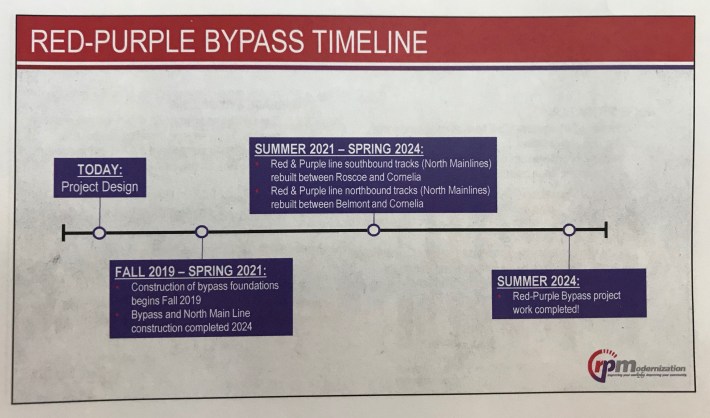
The CTA will open a community project office later this fall in the LBBM area where residents can get info and provide input. "We've never done that before," Carter said.
Next we left the bunker for a short tour of nearby CTA facilities with Bushell. At the north end of the Belmont station platform, he showed us the future site of the flyover, which will go past an existing signal control tower, with the top of the northbound Brown Line train passing a bit higher than the top of the tower.
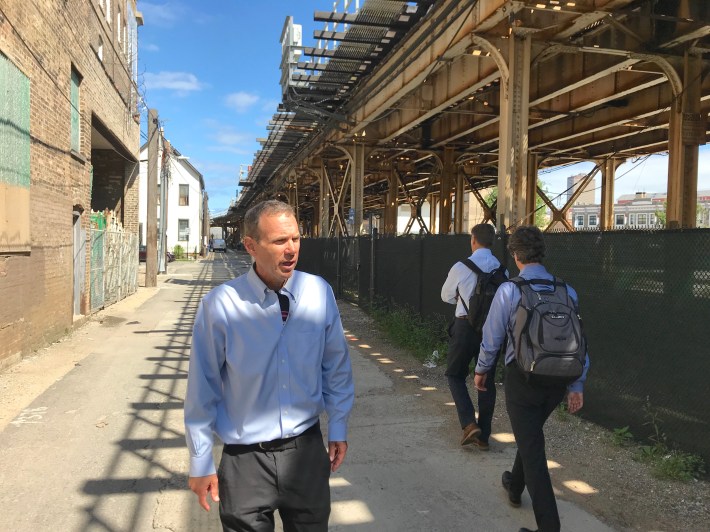
Next we headed north down the alley under the Red/Purple tracks. Bushell said the tracks will be expanded further over the public right of way, something the CTA has done at other sites. Track utility lines will be moved underground to prevent service disruptions due to falling trees, and dirt surfaces under the tracks will be replaced by pavement.
On the way back to the Belmont Army building, we walked down Wilton Avenue, past a gravel parking lot to the east of the Belmont station where buildings were demolished for the Brown Line Capacity project a decade ago. It's a bit of an eyesore, which the CTA has tried to camouflage with evergreens and flowers in planters.
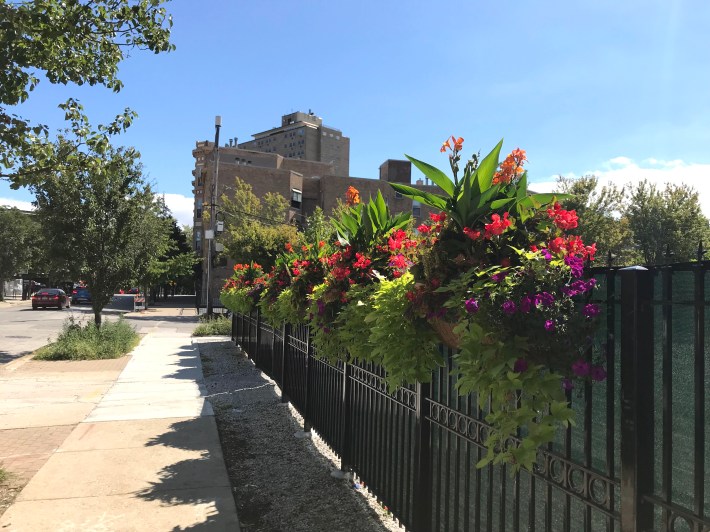
I noted that, due to this history, some residents may be understandably concerned that the vacant lots created by the demolitions for the flyover may never be redeveloped. Bushell said that the CTA has long been planning to use some of this land for RPM, but they couldn't announce that until the funding was lined up. After the project is completed, the remaining real estate may be sold off to a developer.
Bushell added that while the Brown Line project didn't involve a redevelopment strategy, for RPM the CTA collected community input for a transit-oriented development plan, which he said should help reassure neighbors. "We asked them what kind of buildings they want to see when we start to sell off these properties in 2024 or 2025."
For updates on the RPM project, email RPM@transitchicago.com with the subject line "Add to list."
In addition to editing Streetsblog Chicago, John writes about transportation and other topics for additional local publications. A Chicagoan since 1989, he enjoys exploring the city on foot, bike, bus, and 'L' train.
Stay in touch
Sign up for our free newsletter
More from Streetsblog Chicago
Johnson appoints one West Side pastor to CTA board, then nominates another West Side pastor for RTA board
Supporters argue that, despite his lack of transit expertise, Ira Acree’s social justice experience and political connections could be an asset for the RTA board.
Today’s Headlines for Thursday, April 26
The de-facto ban on riverwalk biking is back. What should we do about it?
In the short term, new signage is needed to designate legal areas for cycling on the path. In the long term CDOT should build the proposed Wacker Drive protected bike lane.


